
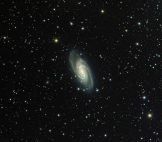
NGC 2903 - Spiral Galaxy in Leo423 viewsA barred spiral galaxy about 30 million light-years from Earth in the constellation Leo the Lion; a member of the Virgo supercluster.
|
|
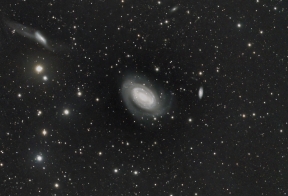
NGC 4725529 viewsA one-armed spiral galaxy in the constellation Coma Berenices, about 41 million light-years from Earth. This is a Seyfert galaxy, meaning that it has a very active nucleus; it is also a barred spiral and has a prominent ring structure. It is interacting with NGC 4747 in the upper left corner of the frame, resulting in severe distortion of both galaxies and producing the spectacular tidal tails seen with NGC 4747. The smaller spiral galaxy to the right of NGC 4725 is NGC 4712.
|
|
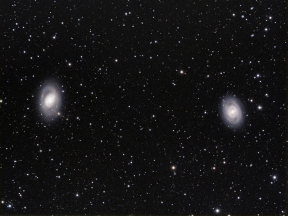
M95 and M96399 viewsTwo Spiral Galaxies in Leo, captured in the same frame
|
|
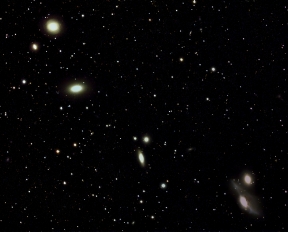
Markarian's Chain500 viewsPart of Markarian's Chain, a group of galaxies in the Virgo Cluster. Visible in the photo are NGCs 4477, 4473, 4461, 4458, 4438 and 4435. Not visible are M84 and M86, which are out of the frame to the right - my telescope's field of view is not big enough to capture them all.
|
|
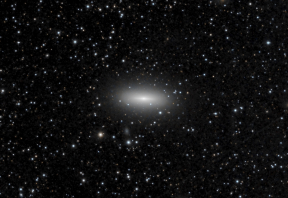
NGC 3115 - Lenticular Galaxy in Sextans484 viewsFormerly thought to be an elliptical galaxy, now considered a lenticular (lens-shaped) galaxy because it has a disk and a central bulge of stars, but no discernible spiral structure. Distance from Earth is about 32 million light years. It is several times larger than the Milky Way galaxy.
|
|
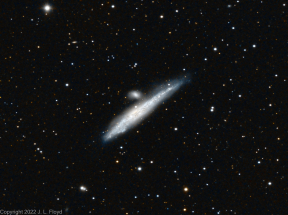
NGC 4631, The Whale Galaxy423 viewsA barred spiral galaxy in the constellation Canes Venatici. Contains a central starburst - a region of intense star formation. The "calf" - the nearby dwarf galaxy - is NGC 4527.
|
|
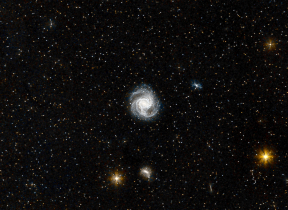
Messier 61 - Face-on Barred Spiral Galaxy in Virgo432 viewsOne of the largest members of the Virgo Cluster, M61 is a starburst galaxy, i.e. it has an unusually high rate of star formation, with an active galactic nucleus that features a massive nuclear star cluster and a supermassive black hole. It is about 53 million light-years away from Earth.
|
|
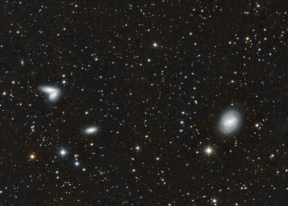
Messier 58 and the Siamese Twins442 viewsM58 is a barred spiral galaxy about 62 million light-years away in the constellation Virgo. The Siamese Twins, NGC 4567 and 4568, are colliding spiral galaxies about 60 million light-years away, in the early stages of merging; they are also nicknamed the Butterfly Galaxies.
|
|
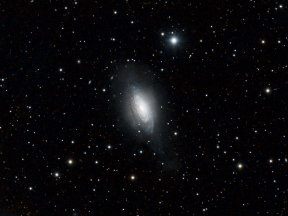
NGC 3521, "flocculent" spiral galaxy in Leo453 viewsNGC 3521 is termed a "flocculent" spiral galaxy because it has patches or clumps of stars breaking up the continuity of the spiral arms. Self-propagating star formation is thought to account for the patchiness. The galaxy lies about 26 million light-years away from us.
|
|
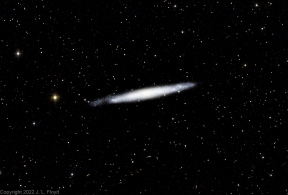
NGC 4244, the Silver Needle Galaxy in Canes Venatici389 viewsAnother "needle" edge-on galaxy, member of a group of galaxies associated with Messier 94 in the Virgo supercluster; about 14 million light-years from Earth.
|
|
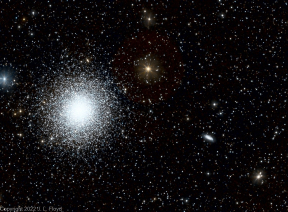
NGC 6207, Spiral Galaxy in Hercules420 viewsNGC 6207 is the small oval object on the right side of the photo, just below the centerline. It is seen nearly edge-on and is about 30 million light-years from Earth. It is somewhat outshone by M13, the large globular cluster on the left, which is of course much closer, at 22,200 light-years from Earth.
|
|
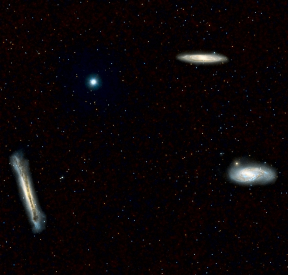
The Leo Galaxy Trio464 viewsA famous triplet of spiral galaxies: Lower right - Messier 66; upper right, Messier 65; lower left, NGC 3628. All about 35 million light years away in the constellation Leo the Lion.
|
|
| 47 files on 4 page(s) |
2 |  |
|

|